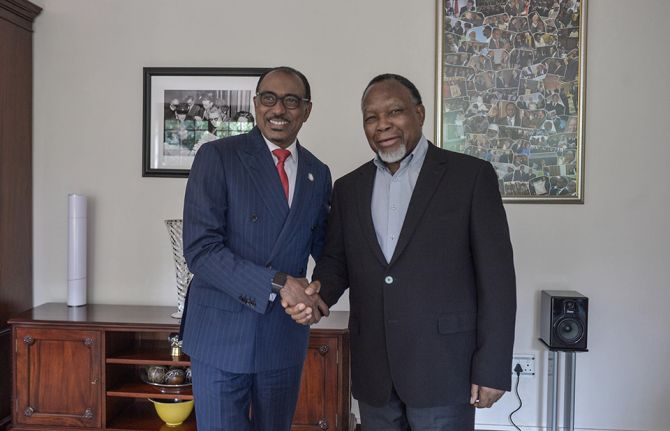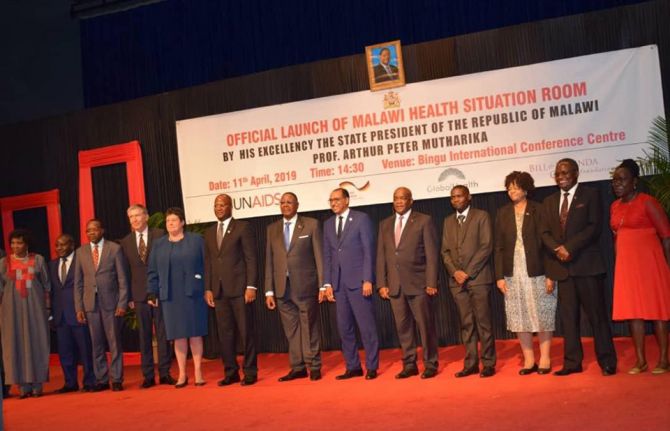
Feature Story
One million lives can be saved between now and the end of 2015 by preventing and treating tuberculosis among people living with HIV
07 June 2011
07 June 2011 07 June 2011
(Left to Right): Dr Jorge Sampaio, UN Secretary-General Special Envoy to Stop TB; Lucica Ditiu, Executive Secretary, The Stop TB Partnership; Michel Sidibé, UNAIDS Executive Director; Osas Ighodaro, Miss Black USA; Ray Chambers, UN Secretary-General Special Envoy for Malaria. UN Headquarters, NYC, on June 6, 2011. Credit: UNAIDS/B.Hamilton
A new epidemiological model produced by the Stop TB Partnership, World Health Organization (WHO) and UNAIDS shows that it is possible to sharply reduce AIDS deaths worldwide by preventing and treating tuberculosis (TB). At present one in four people living with HIV die of TB; the vast majority of these deaths could be averted, since TB is curable.
“Halving TB deaths in people living with HIV by 2015 is possible and is within our reach. We could save up to a million lives by 2015 and bring us one step closer to the UNAIDS vision of zero AIDS-related deaths,” said UNAIDS Executive Director Michel Sidibé.
Building on well-established methods for preventing and treating HIV-associated TB that are recommended by WHO and UNAIDS, the model shows that by scaling up these approaches worldwide a million lives could be saved by the end of 2015.
We could save up to a million lives by 2015 and bring us one step closer to the UNAIDS vision of zero AIDS-related deaths
UNAIDS Executive Director Michel Sidibé.
“There has been a surge in awareness about the deadly TB epidemic among people living with HIV, but insufficient action. Now new scientific work has shown that we can prevent a million deaths among people living with HIV by end 2015 by providing integrated HIV and TB care,” said Dr Jorge Sampaio, the UN Secretary-General's Special Envoy to Stop TB and former President of Portugal. “I call on the world's leaders to take up this challenge. It is time to take bold action. Not to do so would be an outrage.”
A publication that outlines the new model, Time to act: Save a million lives by 2015 - Prevent and treat tuberculosis among people living with HIV, was launched on 6 June at United Nations Headquarters. It calls for the following actions:
- Testing for HIV and TB should be provided every three years in places where both diseases are prevalent.
- Prompt TB treatment needs to be provided to every person living with HIV with active TB—or else treatment to prevent TB.
- HIV and TB treatment must be accessible and of good quality so that people living with HIV are cured of TB.
- Antiretroviral therapy (ART) should be started early, which will help prevent TB, since people living with HIV are far less likely to become ill with and die of TB if they begin ART before their immune systems begin serious decline.
- People who are HIV-positive and diagnosed with active TB should start ART regardless of the status of their immune systems.
In 2010 the Stop TB Partnership and UNAIDS set the joint goal of reducing by half the number of deaths among people living with HIV, compared to 2004 levels, between 2011 and end 2015. With the new model, they have agreed to aim to avert one million deaths.
New scientific work has shown that we can prevent a million deaths among people living with HIV by end 2015 by providing integrated HIV and TB care
Dr Jorge Sampaio, UN Secretary-General's Special Envoy to Stop TB and former President of Portugal.
Civil society is also calling on their governments to fully adopt this TB/HIV plan. “Our message is clear and simple. If people living with HIV don't get tested and treated for TB, many of us will die from this disease, even though we are receiving life-saving antiretroviral treatment. It's a terrible waste, because TB is curable,” said Lucy Chesire, a leading international advocate on behalf of people affected by HIV-associated TB.
It is estimated that the cost of all the elements needed to prevent one million TB deaths among HIV-positive people worldwide would come to about US$ 790 million per year.
UN General Assembly High Level Meeting on AIDS
Thirty years into the AIDS epidemic, and 10 years since the landmark UN General Assembly Special Session on HIV/AIDS, the world has come together to review progress and chart the future course of the global AIDS response at the 2011 UN General Assembly High Level Meeting on AIDS from 8–10 June 2011 in New York. Member States are expected to adopt a new Declaration that will reaffirm current commitments and commit to actions to guide and sustain the global AIDS response.
External links
Related
 Keeping up the momentum in the global AIDS response
Keeping up the momentum in the global AIDS response

24 April 2019
 Malawi launches its health situation room
Malawi launches its health situation room

12 April 2019
 Learning lessons on evaluation
Learning lessons on evaluation

02 April 2019
